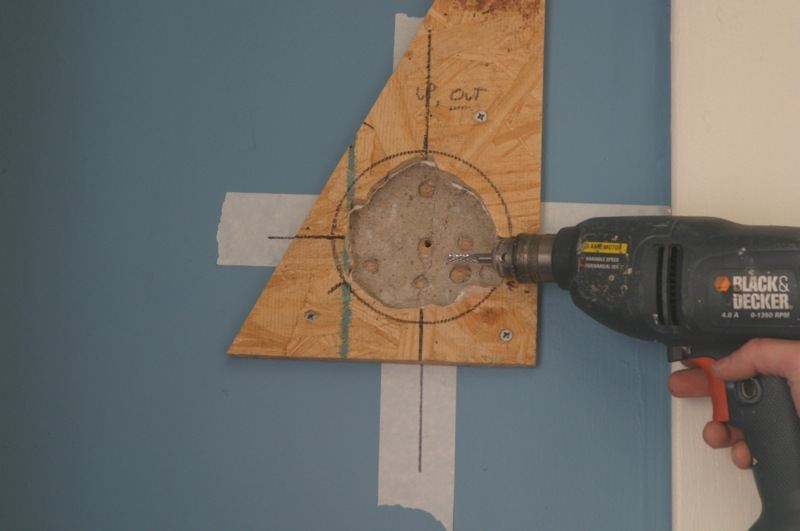The Rotozip tool is part of the newer crop of power that has come out in recent years, adding more features to the traditional tools we all know and love. Like other more unique power tools, it was designed to cut holes in drywall. But the Rotozip tool has gone far beyond that and is used for grinding and cutting holes in just about any material.
This high-speed rotary tool is somewhat like a router but smaller. The particular bits look like a drill bit but differ from a drill in that their fluted edges are sharp, like an end mill, allowing the tool to cut sideways.
That’s the natural beauty of it, as the tool can cut in any direction, even allowing you to change direction quickly, flush cutting through for corner or intricate cuts. The device even provides plunge cuts, eliminating the need for a pilot hole.
It’s not a router, but the Rotozip can be used for several applications that a small router might typically use. This includes laminate trimming, although I haven’t seen an actual laminate trimming bit for it or any trim with attachments and bits or attachments that work together with a bearing. However, it is quite possible that a standard laminate trimming bit would work with the tool, as it should fit in the collet.
Rotozip has come out with a good assortment of bits for the tool, allowing it to cut in thin materials, drywall, wood, tile, metal, stone, wood, and even granite. These bits are mostly 1/4” in diameter, although a few 1/8” bits work with a step-down collet saw adapter.
While a couple of other power tool companies have now entered the drywall holes and ceiling tile on the top market with their versions of the Rotozip, called by the more generic name of “rotary saws,” drywall cutters,” or “rotary tile cutters, the original product line still dominates the market with the lowest price and ease of use. Some of these companies also manufacture cordless versions of the tool.
Using Rotozip with Plywood
Perhaps one of the best unsung uses of the Rotozip is when cutting plywood. The high-speed rotary bit of the Rotozip eliminates the problem of splintering that is so common with plywood.
While any crosscutting operation done on thin materials such as plywood is likely to splinter, the biggest problem is when using a jigsaw to cut plywood. The reason for it is the up-and-down cutting action of the blade tends to rub against the edge of the cement board and the surface veneer, causing it to splinter.
The Rotozip eliminates that action, causing a considerably smoother cut.
Since a straight edge guide the blade of the spiral saw of the Rotozip bit is round and is cutting in all directions at once, the Rotozip can be used for intricate shapes as long as the cuts are more comprehensive than the diameter of cut holes in the edge of the bit.
Work similar to that usually requires a scroll saw but can be accomplished easily using a Rotozip.
The maximum depth of cut of materials with the Rotozip is one inch, but shallower cuts can also be made. The tool’s foot is easily adjusted to control the depth of cutouts of material being cut with the turn of a thumbscrew.
Changing Bits on a Rotozip
The Rotozip tool and competing brands use a collet for gripping the bit, much like a blade router. A locking button is depressed to prevent the motor shaft from turning, and then the collet can be loosened with an open-end wrench. The new bit is slipped into the collet, and the collet is tightened.
As with a router, it is essential to fully seat the bit into the collet. If only the end of the flex shaft attachment of the bit is in the collet, there will be uneven pressure on the metal bit shaft, and the bit will gradually work its way freehand and cut loose. The collet needs to be tightened thoroughly to help prevent this problem from occurring.

Rotozip bit in a regular drill, Matt Wyczalkowski
Rotozip Accessories Expand its Capability
The essential tool allows plunge cutting in various materials, making holes of almost any shape. First and foremost is their circle guide, which helps the Rotozip cut perfect circles of nearly any building material or size from 4” up to 12” in diameter.
Unlike using a circle cutter with many different bits and other tools, the same accessory can be used as a multi-tool to create and cut inside and outside circles, providing greater flexibility.
A replacement collet kit allows the tool to be used with 1/8”, 5/32”, and 1/4” bits, including bits and devices from other manufacturers. This expands the capabilities and features of the tool. Replacement brushes and other parts and materials are readily available.
The Rotozip toolbox can also be used as a cutoff tool with the direct drive cutoff saw attachment. This provides the control and an electric cutoff cutting tool that runs 50% faster than pneumatic ones, making the job quicker and smoother.
Considering the amount of sawdust the saw and tool can make, Rotozip also produces a dust collection port for the saw and system, allowing the saw and device to be adapted to work with a ShopVac or other dust collection system.
Some attachments for the Rotozip seem to be no longer available, even though they would be a helpful tool. These include a baseplate for ripping plywood walls off with the Rotozip and a jigsaw handle.
It allows the tool to be more easily controlled when being cutouts used in place of a full jigsaw handle.

